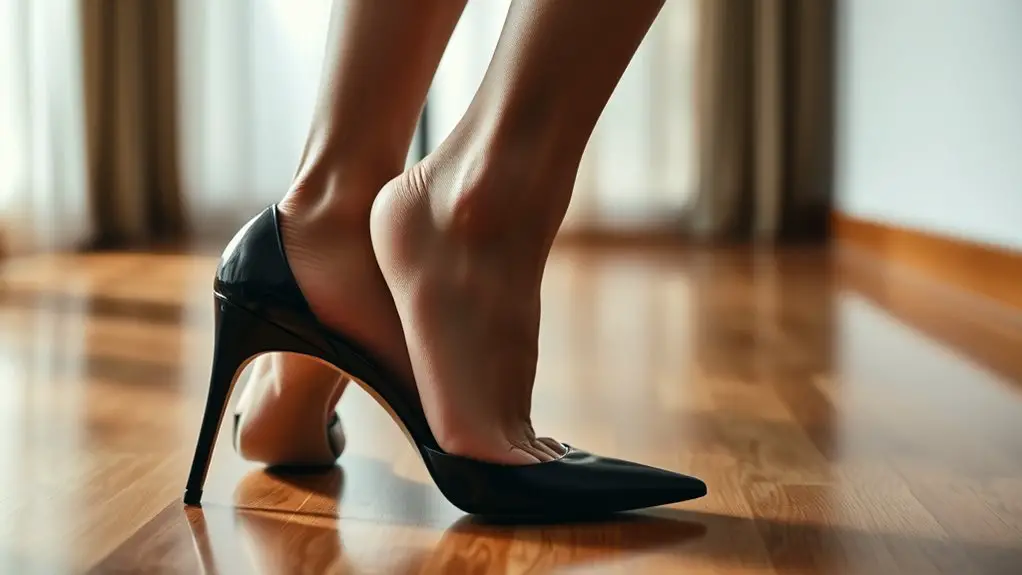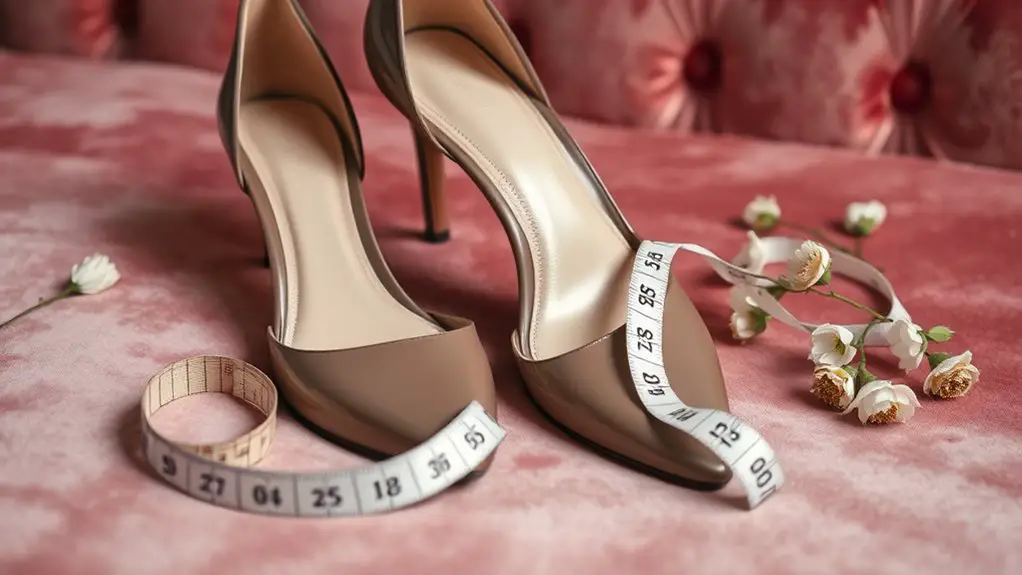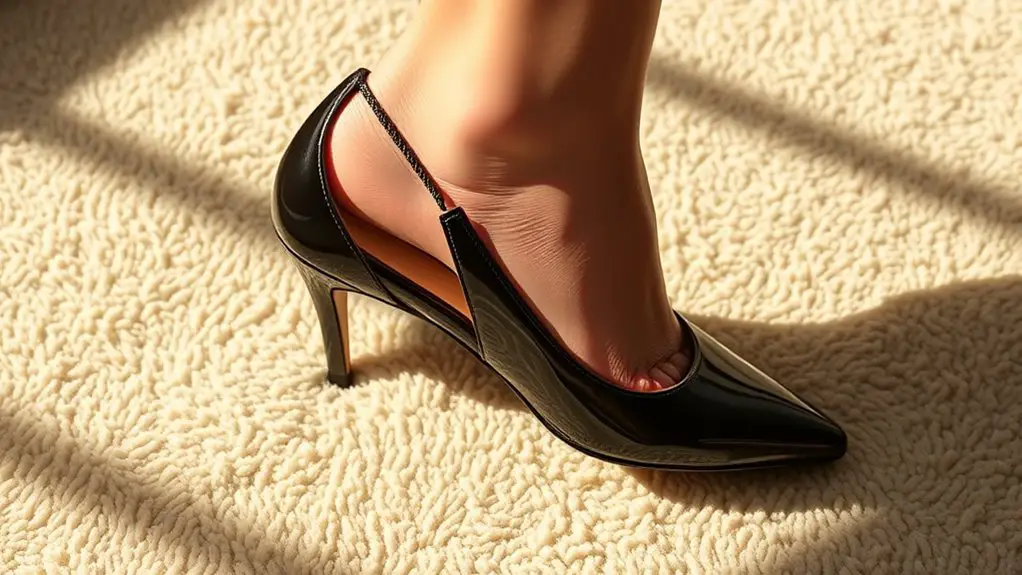The science behind high heel comfort involves understanding their biomechanics, which alter foot alignment and posture. When you wear heels, your center of gravity shifts, leading to increased strain on your forefoot and calves. This can result in foot issues like bunions and plantar fasciitis. Innovations in design, such as enhanced arch support and cushioning, help mitigate discomfort. Choosing the right heel height and materials can further improve your experience. Explore some effective strategies that can boost your comfort.
Understanding the Biomechanics of High Heels

When you slip on a pair of high heels, it’s not just your fashion sense that changes; the biomechanics of your body also shift greatly. High heels alter your foot structure by elevating the heel and forcing your foot into a pointed position, which affects your natural alignment. This shift can disrupt your gait, as your center of gravity moves forward. Gait analysis reveals that wearing high heels increases the load on the forefoot, while decreasing the shock absorption capacity of the heel. This alteration in biomechanics can lead to compensatory movements in the hips and knees, further impacting your overall posture. The change in foot structure also affects muscle activation patterns, leading to increased strain on the calf muscles and tendons. Understanding these biomechanical effects is essential for evaluating comfort and performance while wearing high heels, as they can have significant implications on your movement and stability.
The Impact of High Heels on Foot Health
Though high heels may enhance your appearance, they can greatly compromise your foot health over time. The altered foot anatomy from wearing heels can lead to various complications, including bunions, hammertoes, and plantar fasciitis. These conditions often result in chronic pain, necessitating effective pain management strategies.
| Condition | Description | Pain Management Strategies |
|---|---|---|
| Bunions | Deformity at the base of the big toe | Custom orthotics, ice therapy |
| Hammertoes | Abnormal toe positioning | Toe exercises, splints |
| Plantar Fasciitis | Inflammation of the tissue on the bottom of the foot | Stretching, anti-inflammatory meds |
| Metatarsalgia | Pain in the ball of the foot | Cushioning insoles, foot massages |
Understanding these impacts can help you make informed decisions regarding your footwear choices, ultimately preserving your foot health while still enjoying style.
Posture and Balance: How Heels Affect Your Body

High heels significantly alter your body’s posture and balance, which can lead to a range of physical issues. When you wear heels, your center of gravity shifts forward, forcing your body to compensate. This adjustment often results in exaggerated lumbar lordosis, or an increased curve in the lower back, which can cause discomfort and pain over time. While some argue that high heels can enhance balance improvement by engaging specific muscle groups, the engagement is often limited and not sustainable for prolonged wear. The calf muscles and the muscles surrounding the ankle may be activated, but this can lead to muscle fatigue and strain. Additionally, the altered biomechanics can increase the risk of falls or ankle injuries. Understanding these effects is essential for making informed choices about high heel wear and maintaining long-term body health.
Innovations in High Heel Design for Enhanced Comfort
As designers increasingly recognize the discomfort associated with traditional high heels, innovations in design are emerging to prioritize wearers’ comfort without sacrificing style. One significant advancement is the incorporation of advanced cushioning technology. This technology utilizes materials like memory foam and gel inserts, which adapt to your foot’s shape and provide a softer landing with each step.
Additionally, enhanced arch support has become a focal point in high heel design. By integrating contoured footbeds and adjustable straps, manufacturers can promote better foot alignment, reducing strain on the arches and minimizing fatigue.
These innovations not only improve comfort but also encourage longer wear times, allowing you to enjoy your stylish footwear without the usual pain. As the industry evolves, you can expect to see even more features aimed at enhancing comfort, making high heels a more viable option for everyday wear.
Tips for Choosing Comfortable High Heels

When selecting comfortable high heels, understanding key features can greatly impact your experience. First, consider heel height; a lower heel, ideally between 1 to 2 inches, distributes weight more evenly and minimizes strain on your feet. If you prefer a higher heel, look for options with a platform that can provide additional cushioning.
Next, focus on material selection. Opt for soft, breathable materials like leather or suede, which can accommodate foot movement without causing discomfort. Additionally, look for shoes with cushioned insoles and arch support, as these features enhance comfort considerably.
Finally, verify the shoes fit well; too tight or too loose can lead to pain. Trying on shoes later in the day when your feet are slightly swollen can help guarantee a proper fit. By considering these factors, you’ll increase your chances of finding high heels that won’t compromise on comfort.
Frequently Asked Questions
Can Wearing High Heels Affect My Overall Body Alignment?
Have you ever considered how those stylish heels impact your body posture? Wearing high heels can lead to alignment issues, straining your spine and altering your natural gait, ultimately affecting your overall body alignment and comfort.
How Do High Heels Impact Knee and Hip Joints?
Wearing high heels increases knee stress and can lead to misalignment in your hips. This altered posture may strain your joints and contribute to discomfort, emphasizing the importance of understanding their long-term effects on your body.
Are Certain Foot Types More Prone to Discomfort in High Heels?
Studies show 70% of women experience foot pain in high heels. If you have flat feet or high arches, your foot anatomy can affect comfort levels, as arch height directly influences pressure distribution and joint alignment.
What Are the Long-Term Effects of Wearing High Heels Regularly?
Wearing high heels regularly can negatively impact your foot health, leading to circulation issues, joint pain, and potential deformities. Over time, these effects may exacerbate, causing lasting discomfort and mobility challenges that affect daily activities.
Do High Heels Contribute to Lower Back Pain?
Yes, high heels can contribute to lower back pain due to posture changes they induce. This altered alignment places additional strain on your spine, complicating pain management and potentially leading to chronic discomfort if worn frequently.



